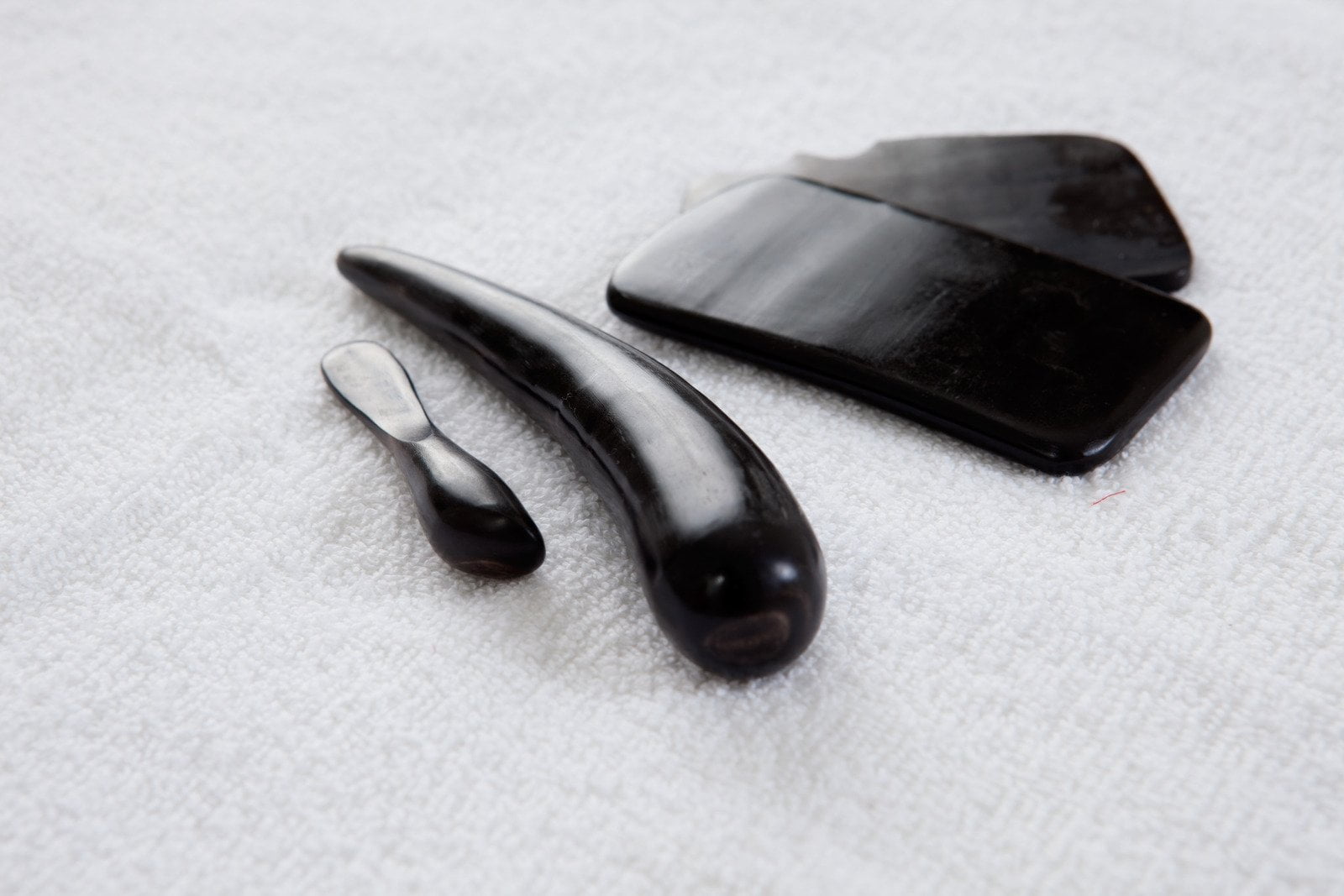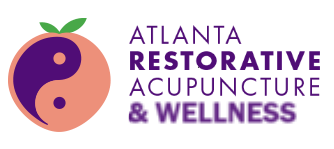The Benefits of Gua Sha
By Dr. David Blake Jones, DACM, LAc, MSPH
Gua Sha is an ancient Chinese Medicine technique, typically a complementary therapy to Acupuncture, for pain relief, fever reduction, and immune regulation/stimulation, that involves the gentle “scraping” of skin. Since the Gua Sha tools used by most practitioners have dull edges, the process is not scary like it sounds. Typically, Gua Sha tools are made from jade stone, stainless steel, or anything thin with a hard but not sharp edge (a minority of practitioners do use Sheep’s horn and other tools with sharp edges) and are shaped to be able to glide along the skin and re-shape the soft tissue (fascia) between the skin and the muscle. Different sized Gua Sha tools are used on different body parts to provide the most effective benefit.

If you are curious to know more about Gua Sha, you likely have heard friends touting it or seen claims supporting its use online. You may have heard it is good for pain, and for stimulating the immune system. However, if you go to Wikipedia to learn more, you will see the following sentence, which is the last sentence in the second paragraph: “Gua sha has no health benefits and can have adverse effects, some of them potentially serious.”
Despite my familiarity with the absurd selective interpretation of evidence by Wikipedia across many different topics, I was still shocked by the write up on Wikipedia. As a Doctor of Acupuncture and Chinese Medicine, I have used Gua Sha as a compliment to Acupuncture for years on patients and myself, with great effectiveness, with not one patient complaining of any injury from the procedure. My 63 solely five-star reviews (as of April 26, 2021) indicate I am doing something right. Patient testimonials from other practitioners as well, provide anecdotal support for the usefulness and safety of Gua Sha.

Basic science research reveals that the petechiae on the skin produced from Gua Sha signify the extravasation of blood cells in the capillary bed, and a substantial increase in the perfusion of blood in the skin. (Nielsen et al, 2007) The clinical implications of this are supported by additional research that shows that as this blood is reabsorbed and there is a breakdown of hemoglobin, there is an upregulation of HO-1 (Kwong et al., 2009), an anti-oxidant, anti-inflammatory and cytoprotective enzyme, at multiple internal organ sites immediately after treatment and over a period of days following gua sha treatment, (Xia et al., 2008) An increase of HO-1 expression decreases allergic inflammation. This anti allergic effect occurs partially via inhibition of Th2 cell-specific chemokines (Xia et al., 2008).
In terms of its anti-viral effects, upregulation of HO-1 leads to reduced hepatitis C virus (HCV) replication, as well as antioxidant effects. This signals a potential role for HO-1 in antiviral therapy and therapeutic protection against hepatocellular injury in Hepatitis C infection (Zhu et al, 2008). Indeed, there is now increased understanding about how gua sha helps in the treatment of active chronic hepatitis B as well. As with Hepatitis C infections, there is evidence that the upregulation of the HO-1 enzyme is also effective in the control of hepatitis B virus (HBV) infection. Animal models in fact indicate that it offers hepatoprotection (Wunder et al, 2003)]. Furthermore, a case study indicates that Gua Sha can reduce inflammation caused by active chronic hepatitis (Chan et al, 2011) as well as mastitis, which sometimes involves an infection (Chiu et al, 2010)

Thus, despite the still small number of Western studies directly testing the effectiveness of Gua Sha for reducing infectious diseases, fever, and allergic and inflammatory conditions like asthma and bronchitis, respectively, this emerging basic science research on Gua Sha’s role in augmenting the levels of HO-1 in the body suggests that Gua Sha would have positive immune system impacts.
As for pain relief, one randomized clinical trial has documented that Gua Sha improves painful conditions presenting as neck pain (Braun et al., 2011) Additional research suggests that it is also beneficial for migraine headache (Schwickert et al, 2007), and postherpetic neuralgia (Nielsen, 2005).
As for pain relief, one randomized clinical trial has documented that Gua Sha improves painful conditions presenting as neck pain (Braun et al., 2011) Additional research suggests that it is also beneficial for migraine headache (Schwickert et al, 2007), and postherpetic neuralgia (Nielsen, 2005).
At Atlanta Restorative Acupuncture, Dr. Jones mainly uses Gua Sha to reshape the fascia, or connective tissue in between muscle and skin. When injuries occur, the body heals, but the new soft tissue that forms is typically not as supple and smooth as the pre-injury tissue. The Gua Sha, along with Acupuncture and Electro-Acupuncture, remove or reduce the negative trophic changes and assist in the restoration of form, function, range of motion and pain free movement. If you would like to experience the benefits of Gua Sha, call Dr. Jones now for a free consultation, and find out how he integrates this ancient medical practice into Acupuncture treatment plans.
Sources (thanks to Dr. Arya Nielsen at Pacific College for providing the references for this piece)
- Braun M, Schwickert M, Nielsen A et al. Effectiveness of Traditional Chinese “Gua Sha” Therapy in Patients with Chronic Neck Pain; A Randomized Controlled Trial. Pain Med. 2011;12(3) (January 28):362-9.
- Chan S, Yuen J, Gohel M, Chung C, Wong H, Kwong K. Guasha-induced hepatoprotection in chronic active hepatitis B: A case study. Clin Chim Acta. 2011; 412; 1686-1688.
- Chiu J-Y, Gau M-L, Kuo S-Y, Chang Y-H, Kuo S-C, Tu H-C. Effects of Gua-Sha therapy on breast engorgement: a randomized controlled trial. J Nurs Res. 2010;18(1) (March):1-10.
- Kwong KK, Kloetzer L, Wong KK et al. Bioluminescence imaging of heme oxygenase-1 upregulation in the Gua Sha procedure. J Vis Exp. 2009
- Nielsen A. Postherpetic neuralgia in the left buttock after a case of shingles. Explore (NY). 2005;1(1) (January):74.
- Nielsen A, Knoblauch NTM, Dobos GJ, Michalsen A, Kaptchuk TJ. The effect of Gua Sha treatment on the microcirculation of surface tissue: a pilot study in healthy subjects. Explore (NY). 2007;3(5) (October):456-466.
- Nielsen A 2007 ‘Gua sha’ and the Scientific Gaze: Original Research on an Ancient Therapy in a Call for Discourse in Philosophies of Medicine [doctoral dissertation] Union Institute and University
- Schwickert ME, Saha FJ, Braun M, Dobos GJ. [Gua Sha for migraine in inpatient withdrawal therapy of headache due to medication overuse.]. Forsch Komplementmed. 2007;14(5) (October):297-300.
- Wunder C, Potter RF. The heme oxygenase system: its role in liver inflammation. Curr Drug Targets Cardiovasc Haematol Disord. 2003; 3:199-208.
- Xia ZW, Zhong WW, Meyrowitz JS, Zhang ZL. The role of heme oxygenase-1 in T cell-mediated immunity: the all-encompassing enzyme. Curr Pharm Des. 2008;14(5):454-464.
- Zhu Z, Wilson AT, Mathahs MM et al. Heme oxygenase-1 suppresses hepatitis C virus replication and increases resistance of hepatocytes to oxidant injury. Hepatology. 2008;48(5) (November):1430-1439.
Can gua sha be harmful?
Does gua sha have side effects? As a natural healing remedy, gua sha is safe. It’s not supposed to be painful, but the procedure may change the appearance of your skin. Because it involves rubbing or scraping skin with a massage tool, tiny blood vessels known as capillaries near the surface of your skin can burst.
Does Gua Sha release toxins?
The purpose of Gua Sha is to relax the surrounding muscles. It draws toxins out from deep within the muscles and body. This allows them to the body to flush them away and nourish the local area with fresh blood. These toxins are a result of the congestion of Qi and blood in the body.
Testimonial
This letter is to thank you so much for the acupuncture treatments. As you know, the constant pain I had been experiencing was emitting from the back area, somewhere near the top of the shoulder blade. Lifting my head or turning it to the right caused severe pain. Sometimes the pain radiated down into my right arm. Also, the fingers on my right hand were numb. When I first came to you, I had already been to physical therapy for my neck and shoulder pain. The physical therapy, which included ice packs, heat, traction and manual manipulation, only alleviated the pain somewhat and for a very short period. I had also had chiropractic treatments, which didn’t help at all. Before seeing you, I had never had acupuncture before, but was in such pain that I was willing to try anything. After your first treatment, I felt better. After the second, I had substantial relief. By the third treatment, the pain was nearly gone. And by the fourth treatment, I felt like I was back to normal. I’m grateful for your caring, patient manner and kindness. You are a very dear man. Thank you very much. Sincerely, Susan Allison
Learn More About Our Acupuncture Services:
